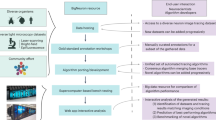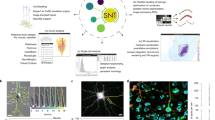Abstract
The V3D system provides three-dimensional (3D) visualization of gigabyte-sized microscopy image stacks in real time on current laptops and desktops. V3D streamlines the online analysis, measurement and proofreading of complicated image patterns by combining ergonomic functions for selecting a location in an image directly in 3D space and for displaying biological measurements, such as from fluorescent probes, using the overlaid surface objects. V3D runs on all major computer platforms and can be enhanced by software plug-ins to address specific biological problems. To demonstrate this extensibility, we built a V3D-based application, V3D-Neuron, to reconstruct complex 3D neuronal structures from high-resolution brain images. V3D-Neuron can precisely digitize the morphology of a single neuron in a fruitfly brain in minutes, with about a 17-fold improvement in reliability and tenfold savings in time compared with other neuron reconstruction tools. Using V3D-Neuron, we demonstrate the feasibility of building a 3D digital atlas of neurite tracts in the fruitfly brain.
This is a preview of subscription content, access via your institution
Access options
Subscribe to this journal
Receive 12 print issues and online access
$209.00 per year
only $17.42 per issue
Buy this article
- Purchase on Springer Link
- Instant access to full article PDF
Prices may be subject to local taxes which are calculated during checkout






Similar content being viewed by others
References
Peng, H. Bioimage informatics: a new area of engineering biology. Bioinformatics 24, 1827–1836 (2008).
Wilt, B.A. et al. Advances in light microscopy for neuroscience. Annu. Rev. Neurosci. 32, 435–506 (2009).
Abramoff, M.D., Magelhaes, P.J. & Ram, S.J. Image processing with ImageJ. Biophotonics Int. 11, 36–42 (2004).
Pettersen, E.F. et al. UCSF Chimera—a visualization system for exploratory research and analysis. J. Comput. Chem. 25, 1605–1612 (2004).
Schroeder, W., Martin, K. & Lorensen, B . Visualization Toolkit: An Object-Oriented Approach to 3D Graphics, 4th edn. (Kitware, Inc, Clifton Park, New York, USA, 2006).
Yoo, T. . Insight into Images: Principles and Practice for Segmentation, Registration, and Image Analysis (A K Peters, Ltd., Wellesey, Massachusetts, USA, 2004).
Long, F., Peng, H., Liu, X., Kim, S. & Myers, E.W. A 3D digital atlas of C. elegans and its application to single-cell analyses. Nat. Methods 6, 667–672 (2009).
Wright, R.S. & Lipchak, B. . OpenGL Superbible, 3rd edn. (Sams Publishing, Indianapolis, Indiana, 2005).
Chen, J.Y.C. & Thropp, J.E. Review of low frame rate effects on human performance. IEEE Trans. Syst. Man Cybern. A Syst. Hum. 37, 1063–1076 (2007).
Westheimer, G. Visual acuity. Annu. Rev. Psychol. 16, 359–380 (1965).
Fukunaga, K. & Hostetler, L.D. The estimation of the gradient of a density function, with applications in pattern recognition. IEEE Trans. Inf. Theory 21, 32–40 (1975).
Roysam, B., Shain, W. & Ascoli, G.A. The central role of neuroinformatics in the national academy of engineering's grandest challenge: reverse engineer the brain. Neuroinformatics 7, 1–5 (2009).
Dijkstra, E.W. A note on two problems in connexion with graphs. Numerische Mathematik 1, 269–271 (1959).
Peng, H., Long, F., Liu, X., Kim, S. & Myers, E. Straightening C. elegans images. Bioinformatics 24, 234–242 (2008).
Yu, H., Chen, C., Shi, L., Huang, Y. & Lee, T. Twin-spot MARCM to reveal the developmental origin and identity of neurons. Nat. Neurosci. 12, 947–953 (2009).
Al-Kofahi, K. et al. Rapid automated three-dimensional tracing of neurons from confocal image stacks. IEEE Trans. Inf. Technol. Biomed. 6, 171–187 (2002).
Al-Kofahi, K. et al. Median-based robust algorithms for tracing neurons from noisy confocal microscope images. IEEE Trans. Inf. Technol. Biomed. 7, 302–317 (2003).
Wearne, S.L. et al. New techniques for imaging, digitization and analysis of three-dimensional neural morphology on multiple scales. Neuroscience 136, 661–680 (2005).
Zhang, Y. et al. Automated neurite extraction using dynamic programming for high-throughput screening of neuron-based assays. Neuroimage 35, 1502–1515 (2007).
Meijering, E. et al. Design and validation of a tool for neurite tracing and analysis in fluorescence microscopy images. Cytometry 58A, 167–176 (2004).
Jefferis, G.S. et al. Comprehensive maps of Drosophila higher olfactory centers: spatially segregated fruit and pheromone representation. Cell 128, 1187–1203 (2007).
Murthy, M., Fiete, I. & Laurent, G. Testing odor response stereotypy in the Drosophila mushroom body. Neuron 59, 1009–1023 (2008).
Cannon, R.C., Turner, D.A., Pyapali, G.K. & Wheal, W.H. An on-line archive of reconstructed hippocampal neurons. J. Neurosci. Methods 84, 49–54 (1998).
Acknowledgements
This work is supported by Howard Hughes Medical Institute. We thank B. Lam, Y. Yu, L. Qu, and Y. Zhuang (Janelia, HHMI) in helping reconstruction of neurites, Y. Yu and L. Qu (Janelia, HHMI) for developing some V3D plug-ins, S. Kim and X. Liu (Stanford) for C. elegans confocal images, R. Kerr and B. Rollins (Janelia, HHMI) for the 5D C. elegans SPIM images, T. Lee and H. Yu (Janelia, HHMI) for single neuron images, C. Doe (Univ. of Oregon, HHMI) for fruitfly embryo images, A. Jenett (Janelia, HHMI) for fly brain compartments, P. Chung (Janelia, HHMI) for the raw images of fruitfly GAL4 lines, S. Sternson and Y. Aponte (Janelia, HHMI) for the mouse brain image, and K. Eliceiri and C. Rueden (Univ. of Wisconsin, Madison) for assistance in implementing a V3D plug-in. We also thank G. Rubin, and R. Kerr (Janelia, HHMI) for helpful comments on the manuscript.
Author information
Authors and Affiliations
Contributions
H.P. designed this research and developed the algorithms and systems, did the experiments and wrote the manuscript. Z.R. and F.L. helped develop the systems. J.H.S. provided raw images for building the neurite atlas. E.W.M. supported the initial proposal of a fast 3D volumetric image renderer. E.W.M., F.L. and J.H.S. helped write the manuscript.
Corresponding author
Ethics declarations
Competing interests
The authors declare no competing financial interests.
Supplementary information
Supplementary Text and Figures
Supplementary Figs. 1–3 and Supplementary Note (PDF 1075 kb)
Supplementary Video 1
3D visualization of a digital model of a fruit fly brain. Magenta voxels: the 3D volumetric image of a fruit fly brain; green voxels: a 3D GAL4 neurite pattern; colored surface objects of irregular shapes: digital models of various brain compartments; colored tree-like surface objects: two 3D reconstructed neurons. (MOV 7684 kb)
Supplementary Video 2a
Hierarchical visualization of a fruit fly brain: The global 3D viewer. (MOV 6697 kb)
Supplementary Video 2b
Hierarchical visualization of a fruit fly brain: Local 3D viewer for region A of Fig. 1c. (MOV 6455 kb)
Supplementary Video 2c
Hierarchical visualization of a fruit fly brain: The local 3D viewer for region B in Fig. 1c is used for tracing neurite and proofreading the reconstruction in 3D. (MOV 6668 kb)
Supplementary Video 3a
3D pinpointing methods in V3D: Pinpointing using 2-clicks. (MOV 3133 kb)
Supplementary Video 3b
3D pinpointing methods in V3D: Pinpointing using 1-click. (MOV 3400 kb)
Supplementary Video 4
3D counting of neurons in the arcuate nucleus of the hypothalamus of a mouse brain. For better visibility, only a small trunk of data is displayed. Red: AgrP neurons infected with FLEX-AAV-ChR2-td-tomato virus; blue: DAPI staining indicating the cell bodies of neurons; green spheres: markers indicating the locations of neurons. (MOV 6822 kb)
Supplementary Video 5
5D volumetric image visualization and quantitative measuring for C. elegans neurons. A series of SPIM images (Supplementary Figure 3) were used. The neuron centers 1~8 were directly pinpointed. 3D line segments were defined between them for profiling both voxel intensity and distance between the moving neurons. (MOV 4334 kb)
Supplementary Video 6
The use of V3D-Neuron in visualization, reconstruction, and proofreading of the 3D morphology of a fruit fly neuron. (MOV 6401 kb)
Supplementary Video 7
A 3D atlas of 111 stereotyped neurite tracts in a fruit fly brain. The width of a tract indicates the spatial variation of its location. (MOV 6802 kb)
Supplementary Video 8
V3D-Neuron can display a neuron in multiple ways (see Methods). (MOV 6305 kb)
Supplementary Video 9
Editing a neuron using V3D-Neuron (see Methods). (MOV 2951 kb)
Supplementary Video 10
Display of multiple neurons in V3D-Neuron. The first half shows how to display the atlas of fruit fly neurite tracts in Figure 6. The second half shows how to display multiple mouse brain neurons. (MOV 6892 kb)
Rights and permissions
About this article
Cite this article
Peng, H., Ruan, Z., Long, F. et al. V3D enables real-time 3D visualization and quantitative analysis of large-scale biological image data sets. Nat Biotechnol 28, 348–353 (2010). https://doi.org/10.1038/nbt.1612
Received:
Accepted:
Published:
Issue Date:
DOI: https://doi.org/10.1038/nbt.1612
This article is cited by
-
Current and future applications of light-sheet imaging for identifying molecular and developmental processes in autism spectrum disorders
Molecular Psychiatry (2024)
-
Mapping of individual sensory nerve axons from digits to spinal cord with the transparent embedding solvent system
Cell Research (2024)
-
Human Purkinje cells outperform mouse Purkinje cells in dendritic complexity and computational capacity
Communications Biology (2024)
-
Stimulus edges induce orientation tuning in superior colliculus
Nature Communications (2023)
-
Heterogeneous receptor expression underlies non-uniform peptidergic modulation of olfaction in Drosophila
Nature Communications (2023)



